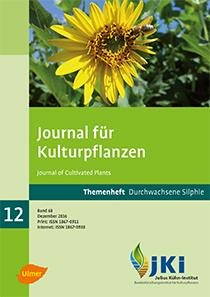Effect of nitrogen fertilizer and compost on photosynthesis and growth of Virginia fanpetals <em>(Sida hermaphrodita</em> Rusby<em>)</em>
DOI:
https://doi.org/10.5073/JfK.2016.12.13Keywords:
Renewable resources, bioenergy, biomass, marginal lands, gas exchange, chlorophyll, fertilizationAbstract
As a perennial bioenergy crop Sida hermaphrodita can play an important role on marginal lands in the near future. In a controlled pot experiments the influence of various proportions of compost (10, 20, 30, 50%) and nitrogen fertilizer (100 kg N ha–1) on biomass, plant height, and carbon allocation were investigated during the establishment phase. Furthermore, ecophysiological parameters (gas exchange, chlorophyll fluorescence, chlorophyll content,) were determined with non-destructive methods. The results of this experiment demonstrated that nitrogen fertilization and compost application has an overall positive effect on the overall growth performance. During the establishment phase, the fertilized plants reached a mean high of up to 127 cm (maximal plant height up to 168 cm). Photosynthesis was not influenced by the treatments and the mean net CO2-exchange rates varied between 5,8 and 9,9 μmol m–2 s–1 and the electron transport rate between 34,5 and 53,9 μmol m–2 s–1. The application of compost and nitrogen for a better biomass production of Sida on marginal soils is possible, however the growth is limited in the first year with negative effects on the establishment of larger crops.
Downloads
Published
Issue
Section
License
The content of the journal is licensed under the Creative Commons Attribution 4.0 License. Any user is free to share and adapt (remix, transform, build upon) the content as long as the original publication is attributed (authors, title, year, journal, issue, pages).
The copyright of the published work remains with the authors. The authors grant the Journal of Cultivated Plants, the Julius Kühn-Institut and the OpenAgrar repository the non-exclusive right to distribute and exploit the work.







